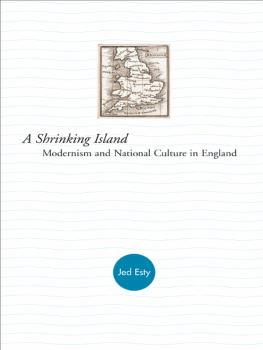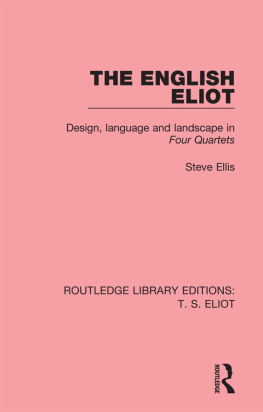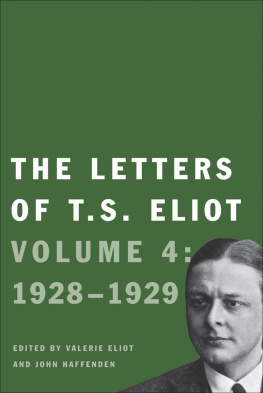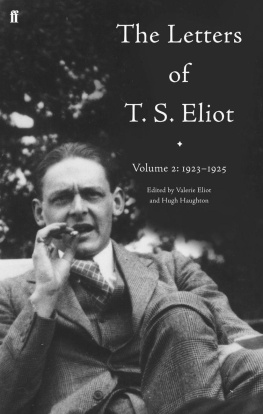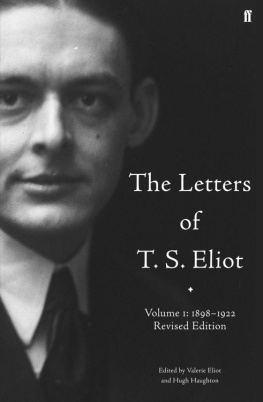Carl Krockel - War Trauma and English Modernism: T. S. Eliot and D. H. Lawrence
Here you can read online Carl Krockel - War Trauma and English Modernism: T. S. Eliot and D. H. Lawrence full text of the book (entire story) in english for free. Download pdf and epub, get meaning, cover and reviews about this ebook. year: 2011, publisher: Palgrave Macmillan, genre: Politics. Description of the work, (preface) as well as reviews are available. Best literature library LitArk.com created for fans of good reading and offers a wide selection of genres:
Romance novel
Science fiction
Adventure
Detective
Science
History
Home and family
Prose
Art
Politics
Computer
Non-fiction
Religion
Business
Children
Humor
Choose a favorite category and find really read worthwhile books. Enjoy immersion in the world of imagination, feel the emotions of the characters or learn something new for yourself, make an fascinating discovery.

- Book:War Trauma and English Modernism: T. S. Eliot and D. H. Lawrence
- Author:
- Publisher:Palgrave Macmillan
- Genre:
- Year:2011
- Rating:3 / 5
- Favourites:Add to favourites
- Your mark:
- 60
- 1
- 2
- 3
- 4
- 5
War Trauma and English Modernism: T. S. Eliot and D. H. Lawrence: summary, description and annotation
We offer to read an annotation, description, summary or preface (depends on what the author of the book "War Trauma and English Modernism: T. S. Eliot and D. H. Lawrence" wrote himself). If you haven't found the necessary information about the book — write in the comments, we will try to find it.
Carl Krockel: author's other books
Who wrote War Trauma and English Modernism: T. S. Eliot and D. H. Lawrence? Find out the surname, the name of the author of the book and a list of all author's works by series.
War Trauma and English Modernism: T. S. Eliot and D. H. Lawrence — read online for free the complete book (whole text) full work
Below is the text of the book, divided by pages. System saving the place of the last page read, allows you to conveniently read the book "War Trauma and English Modernism: T. S. Eliot and D. H. Lawrence" online for free, without having to search again every time where you left off. Put a bookmark, and you can go to the page where you finished reading at any time.
Font size:
Interval:
Bookmark:
The final question I wish to address is why Lawrences and Eliots fortunes differed so greatly in British culture between the two world wars, and continue to in the present. As a cultural era Modernism has been judged by Eliots achievements and failings, rather than by Lawrences whose failings are considered more strictly his own. I want to examine this issue by laying stress on the legacy of these wars in the formation of what has been often called the age of Eliot, not the age of Lawrence.
As we saw in Chapter 5, Lawrence devoted his post-war years to reconciling the dead of war with the living, from the first drafts of Studies in Classic American Literature in 1918: The only thing to do is for each man to remember his dead.... My dead is neither above nor below, nor everywhere. My own dead, whom I have loved and love, is with me, within me, here, now, at one with me, and not elsewhere. In the Foreword to the project, written in 1920, he addressed the issue of America having no tradition How thankful she ought to be! For Lawrence real continuity lay not between Europe and the new States, but between the murdered Red America and the seething White America. The memory of the dead of the First World War was displaced onto the murdered natives, who represented a means to a surpassing of the old European life-form (Studies, 207, 381, 3845).
In 1919 Eliot provided his own statement upon the dead in Tradition and the Individual Talent. By focusing upon the continuity of a cultural tradition he envisaged a way of bridging the historical gap of the war, and of symbolically resurrecting its dead. He wrote regarding the artist: You cannot value him alone; you must set him, for contrast and comparison, among the dead. The dead, associated at this time with the victims of war, here became the tradition of past writers, and through continuing this tradition the artist could bring them into a simultaneous existence with himself, which in turn could bridge the terrible gap of the war, piled up with millions of other voiceless dead (SE, 1415).
Lawrence looked towards an alternative where souls that find in death itself a passionate consummation return to us appeased, and add the beauty and richness of their presence to us; Eliot instead envisaged how the survivors and dead could give life to each other by linking up a tradition. Lawrences notion of death as passionate consummation of the soul offered renewal, as in a natural cycle; in his theory of impersonality Eliot suggested a symbolic identification between the living and dead.
In Chapter 4 we saw how Eliot transformed his numbness towards the incommunicable suffering of the war into an aesthetic impersonality crucial to the Modernist style, as embodied in The Waste Land. Through impersonality the artist could mimic the self-sacrifice of soldiers by undergoing a continual self-sacrifice, a continual extinction of personality. Then through this voluntary renunciation of his individual life he would revive them symbolically: he is not likely to know what is to be done unless he lives in what is not merely the present, but the present moment of the past, unless he is conscious, not of what is dead, but of what is already living (SE, 17, 22). Through enacting this principle of impersonality in his published writings Eliot was able to restrict the war to a concealed presence.
This difference was crucial for Eliots and Lawrences respective positions in Modernist literature: Eliot presented himself as the figure who survived the war intact and able to preserve the cultural tradition intact, while Lawrence repeatedly exposed his wounds in the hope of finding a cure. In Tradition and the Individual Talent, Eliot advocated a process which both commemorated and resurrected the dead, but one which also denied their memory through its ambiguous imagery since the poet ostensibly linked the present generation back to the dead artists, not the soldiers. Read in these terms, though, The Waste Land could achieve this ambivalent form of atonement for contemporary readers: a remembrance of the past, while turning to the future.
One of the most important notions that Eliot popularised in the Twenties was the Mind of Europe. Partly borrowed from Paul Valry, who was attempting to manage a cultural equivalent to the League of Nations, the Mind of Europe was the contemporary manifestation of Eliots tradition, from Homer onwards. While complementing the ill-fated League of Nations, it suggested an alternative to the post-war political situation ratified by the Treaty of Versailles, which only postponed the recurrence of hostilities twenty years later. In terms of the Mind of Europe, then, The Waste Land was read as a mosaic of Europes cultural fragments; while it decried the futility of shoring its fragments against the ruin, its supposed poetic unity offered a vision that left behind the desecration of war, to a Europe whose political and economic differences could be stabilised by its commonly rooted cultural heritage.
Writing in 1926, Allen Tate perhaps understood most the complexity of Eliots appeal to tradition: arranging the past when the future seems to him only vaguely to exist, is in some respects particularly fortunate. It has enabled him to bring to England, in his poetry, the sense of a contemporary spiritual crisis, which shell-shock had already rendered acute. Hence in relating English poetry to European tradition Eliot both had imported the trauma of war and contemplated order which could be extended to the whole of criticism and culture: Tradition and the Individual Talent presupposes a continuity of traditional culture as literature. The baroque agony of the poetry in the corresponding period was preoccupied, however, with the anarchy which he has subsequently rationalized and for which he has proposed as remedy the regime of a critical dictatorship, in The Function of Criticism.
The Waste Land would become known as the model of classical Modernism and of a unified European cultural tradition, while throughout the inter-war period Lawrences Women in Love was largely misunderstood and ignored. This is not to say that Eliots poem was understood while Lawrences novel was not; rather, Eliot had provided a critical discourse by which to interpret his poem in a certain way, while Lawrences own critical writing, such as The Crown and other wartime essays, was not satisfactorily placed by his readers in dialogue with his novel. E.M. Forster commented at Lawrences death that he had still not found his own public the general public thought him improper and did not read him, while a special public regarded him as a god but could not agree upon how he should be worshipped. There was a wealth of insights into his techniques by such readers as Rebecca West, Edwin Muir, Bonamy Dobre and Desmond MacCarthy, but a disparity of judgements regarding the value of his oeuvre, since he lacked a community of readers. They could praise his imagination and genius, but not his artistic method.
Even Eliot can be included among the disparate, half-comprehending members of Lawrences readership. In his review of Aarons Rod in 1922 Over the rest of the period Eliot would continue to suppress this revealing of his inner life, by dismissing Lawrence as lacking conscious control, being fixated upon sensations (and his mother), and heretical.
In the next two sections I will examine how the legacy of the First World War had a more negative effect upon Lawrences reputation than Eliots. I will focus on three of the most prominent writers on Lawrence between the wars: Richard Aldington and John Middleton Murry in the Twenties, and F.R. Leavis in the Thirties. All of their defences of Lawrence were overshadowed by Eliot: he picked up on Aldingtons celebration of Lawrence as a heretic to exclude him from the orthodoxy of classical Modernism. He discredited Murrys philosophy of Romantic individualism which celebrated Lawrence, and set the critical seal of approval on Murrys final denunciation of Lawrence. Finally, he provided Leavis with a critical approach and standards, which Leavis by turns rejected and utilised in his presentation of Lawrence as Eliots alternative in Modernism.
Font size:
Interval:
Bookmark:
Similar books «War Trauma and English Modernism: T. S. Eliot and D. H. Lawrence»
Look at similar books to War Trauma and English Modernism: T. S. Eliot and D. H. Lawrence. We have selected literature similar in name and meaning in the hope of providing readers with more options to find new, interesting, not yet read works.
Discussion, reviews of the book War Trauma and English Modernism: T. S. Eliot and D. H. Lawrence and just readers' own opinions. Leave your comments, write what you think about the work, its meaning or the main characters. Specify what exactly you liked and what you didn't like, and why you think so.

